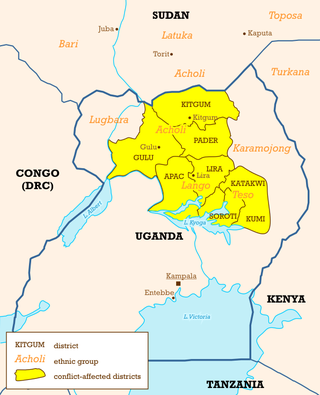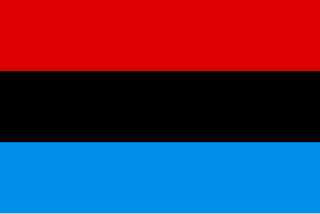
The Uganda People's Defence Force (UPDF), previously known as the National Resistance Army, is the armed forces of Uganda. From 2007 to 2011, the International Institute for Strategic Studies estimated the UPDF had a total strength of 40,000–45,000, consisting of land forces and an air wing. Recruitment to the forces is done annually.

The Lord's Resistance Army insurgency is a conflict involving the Lord's Resistance Army against the government of Uganda. Following the Ugandan Civil War, militant Joseph Kony formed the Lord's Resistance Army and launched an insurgency against the newly installed President Yoweri Museveni. The stated goal was to establish a Christian state based on the Ten Commandments. Currently, there is low-level LRA activity in eastern areas of the Democratic Republic of the Congo and the Central African Republic. Kony proclaims himself the 'spokesperson' of God and a spirit medium.
The Uganda National Liberation Front (UNLF) was a political group formed by exiled Ugandans opposed to the rule of military dictator Idi Amin. The UNLF had an accompanying military wing, the Uganda National Liberation Army (UNLA). UNLA fought alongside Tanzanian forces in the Uganda–Tanzania War that led to the overthrow of Amin's regime. The group ruled Uganda from the overthrow of Amin in April 1979 until the disputed national elections in December 1980.

Juma Abdalla Oris was a Ugandan military officer and government minister during the dictatorship of Idi Amin. After fleeing his country during the Uganda–Tanzania War, he became leader of the West Nile Bank Front (WNBF), a rebel group active in the West Nile region of Uganda during the 1990s.
The Front for National Salvation (FRONASA) was a Ugandan rebel group led by Yoweri Museveni. The group factually emerged in 1971, although it was formally founded in 1973. FRONASA, along with other militant groups such as Kikosi Maalum, formed the Uganda National Liberation Front (UNLF) and its military wing the Uganda National Liberation Army (UNLA) in 1979 to fight alongside Tanzanian forces against Idi Amin.

The start of the period 1994 to 2002 of the Lord's Resistance Army insurgency in northern Uganda saw the conflict intensifying due to Sudanese support to the rebels. There was a peak of bloodshed in the mid-1990s and then a gradual subsiding of the conflict. Violence was renewed beginning with the offensive by the Uganda People's Defence Force in 2002.
The period from 2000 to 2006 of the Lord's Resistance Army insurgency in northern Uganda begins with the assault of the Uganda People's Defence Force (UPDF) upon LRA strongholds in South Sudan. This in turn led to a series of retaliatory attacks by the Lord's Resistance Army of an intensity not seen to since the mid-1990s. International awareness of the conflict gradually grew and in September 2005, the International Criminal Court issues warrants for the arrest of senior LRA commanders, including Joseph Kony.

The Ugandan Bush War was a civil war fought in Uganda by the official Ugandan government and its armed wing, the Uganda National Liberation Army (UNLA), against a number of rebel groups, most importantly the National Resistance Army (NRA), from 1980 to 1986.
The military history of Uganda begins with actions before the conquest of the country by the British Empire. After the British conquered the country, there were various actions, including in 1887, and independence was granted in 1962. After independence, Uganda was plagued with a series of conflicts, most rooted in the problems caused by colonialism. Like many African nations, Uganda endured a series of civil wars and coup d'états. Since the 2000s in particular, the Uganda People's Defence Force has been active in peacekeeping operations for the African Union and the United Nations.

The Lord's Resistance Army (LRA) is a Christian extremist organization operating in Central Africa and East Africa. Its origins were in the Ugandan insurgency (1986–1994) against President Yoweri Museveni, during which Joseph Rao Kony founded the LRA in 1987.

Edward Katumba Wamala, more commonly known as Katumba Wamala, is a Ugandan general who has served as Minister of Works and Transport in the Ugandan cabinet, since 14 December 2019.
Operation Thunderbolt was the codename for a military offensive by the South Sudanese SPLA rebel group and its allies during the Second Sudanese Civil War. The operation aimed at conquering several towns in Western and Central Equatoria, most importantly Yei, which served as strongholds for the Sudanese Armed Forces (SAF) and helped the Sudanese government to supply its allies, the Ugandan insurgents of the WNBF and UNRF (II) based in Zaire. These pro-Sudanese forces were defeated and driven from Zaire by the SPLA and its allies, namely Uganda and the AFDL, in the course of the First Congo War, thus allowing the SPLA to launch Operation Thunderbolt from the Zairian side of the border. Covertly supported by expeditionary forces from Uganda, Ethiopia, and Eritrea, the SPLA's offensive was a major success, with several SAF garrison towns falling to the South Sudanese rebels in a matter of days. Yei was encircled and put under siege on 11 March 1997. At the same time, a large group of WNBF fighters as well as SAF, FAZ, and ex-Rwandan Armed Forces soldiers was trying to escape from Zaire to Yei. The column was ambushed and destroyed by the SPLA, allowing it to capture Yei shortly afterward. Following this victory, the South Sudanese rebels continued their offensive until late April, capturing several other towns in Equatoria and preparing further anti-government campaigns.
Abdulatif Tiyua is a retired Ugandan military officer and former rebel leader. He served as a Uganda Army (UA) commander during the dictatorship of Idi Amin. When Amin was overthrown in 1979 during the Uganda–Tanzania War, Tiyua was imprisoned by the new Ugandan government. He was freed in 1985, when Tito Okello overthrew Ugandan President Milton Obote. When Okello was defeated by Yoweri Museveni's National Resistance Army, Tiyua joined an insurgency in northern Uganda, and eventually rose to deputy commander of the West Nile Bank Front rebel group. Following years of warfare, Tiyua was captured by rebels allied to the Ugandan government in southern Sudan in 1997, and was again incarcerated. After being released in 2000, he became chairman of a veterans association and has lobbied for his former rebel comrades to end their insurgency.

The Acholi people are a Nilotic ethnic group of Luo peoples, found in Magwi County in South Sudan and Northern Uganda, including the districts of Agago, Amuru, Gulu, Kitgum, Nwoya, Lamwo, Pader and Omoro District. The Acholi were estimated to number 2.3 million people and over 45,000 more were living in South Sudan in 2000.
The Uganda Army, also known as Uganda Armed Forces, served as the national armed forces of Uganda during the dictatorship of Idi Amin (1971–1979). It mostly collapsed during the Uganda–Tanzania War, but remnants continued to operate in exile from 1979. These pro-Amin rebel forces continued to be called the "Uganda Army" and maintained a semblance of cohesion until 1980, when they fully fractured into rival factions.
The Uganda Army, also known as the Uganda Rifles, served as the national armed forces of Uganda during the presidencies of Mutesa II and Milton Obote. As time went on, the military was gradually expanded and increasingly interfered in Uganda's national politics. It played a prominent role in defeating local insurgencies, suppressing opposition to Obote, and intervened in conflicts in the Congo as well as Sudan. Dissatisfied soldiers overthrew Obote in 1971, resulting in the establishment of the Second Republic of Uganda under the dictatorship of army commander Idi Amin. The Uganda Army was purged, with thousands of suspected pro-Obote troops killed or fleeing the country. The military was consequently split into an army serving under Amin – the Uganda Army (1971–1980) – and exiled rebel factions. The latter helped to overthrow Amin's regime during the Uganda–Tanzania War of 1978–79, and became the core of the Uganda National Liberation Army which would serve as Uganda's national military from 1980 to 1986.

From 1986 to 1994, a variety of rebel groups waged a civil war against the Ugandan government of President Yoweri Museveni. Most of the fighting took place in the country's north and east, although the western and central regions were also affected. The most important insurgent factions were the Uganda People's Democratic Army (UPDA), the Uganda People's Army (UPA), Alice Auma's Holy Spirit Movement (HSM), and Joseph Kony's army. Several smaller rebel factions and splinter groups of the larger movements waged their own campaigns; the rebels often clashed with each other. All belligerents, including the government, targeted civilians and committed human rights violations. In course of fighting that involved tens of thousands of troops, the Ugandan government was able to gradually defeat or contain most rebel factions. The operations in the north and east caused great destruction and resulted in high civilian casualties.
The Former Uganda National Army was a Ugandan rebel group active during the Ugandan Bush War and the subsequent insurgencies in the country. The group claimed to be a continuation of the Uganda Army under Idi Amin and was made up mostly of Amin loyalists. It came to be led by General Isaac Lumago and Brigadier Amin Onzi. The group was mainly active in Northern Uganda as well as Zaire and Sudan, where they operated rear bases and acquired weapons and equipment.
In October 1980, Uganda's West Nile Region was the site of a major military campaign, as Uganda Army (UA) remnants invaded from Zaire as well as Sudan and seized several major settlements, followed by a counteroffensive by the Uganda National Liberation Army (UNLA) supported by militias and Tanzanian forces. The campaign resulted in large-scale destruction and massacres of civilians, mostly perpetrated by the UNLA and allied militants, with 1,000 to 30,000 civilians killed and 250,000 displaced. The clashes mark the beginning of the Ugandan Bush War.

Bernard Rwehururu was a Ugandan military officer and author. He served in various Ugandan militaries from 1965 until 2013, including under the governments of Milton Obote, Idi Amin, Tito Okello, and Yoweri Museveni.









